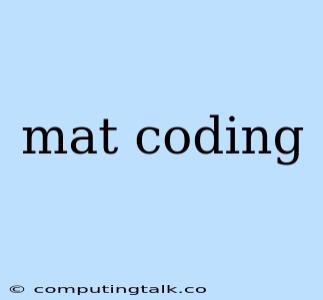Mat Coding: A Guide to Mastery
The term "mat coding" might seem unfamiliar to some, but it's a core concept in the world of programming. Essentially, it refers to the art of creating clean, concise, and efficient code that is easy to understand and maintain. Imagine a chef preparing a dish with the most flavorful ingredients, perfectly seasoned and presented beautifully. That's what mat coding is all about, delivering quality code that's a pleasure to work with.
Why Is Mat Coding Important?
Think about building a house. Would you prefer a house constructed haphazardly with poorly chosen materials, or a house built with a strong foundation, well-planned architecture, and high-quality materials? Mat coding is like building that well-planned house for your software projects.
Here are some key benefits of mat coding:
- Enhanced Readability: Mat code is like a well-written book, easy to follow and understand. This reduces confusion and makes debugging a breeze.
- Reduced Errors: Cleaner code with fewer lines and complex logic minimizes the chances of bugs creeping in.
- Increased Maintainability: When your code is well-structured and easy to understand, it becomes much easier to modify and adapt to new requirements.
- Improved Collaboration: When working with others, mat coding ensures that everyone can understand and contribute effectively.
How to Achieve Mat Coding Mastery
Now that you understand the importance of mat coding, let's explore how you can achieve it.
1. Choosing the Right Tools:
Start with a good code editor or IDE (Integrated Development Environment) like VS Code or PyCharm. These tools provide features like syntax highlighting, auto-completion, and debugging tools, making your coding experience much smoother.
2. Embrace Code Standards:
Following code style guides like PEP 8 for Python or Airbnb JavaScript Style Guide ensures uniformity and consistency. This helps you write code that's not just functional but also aesthetically pleasing.
3. Write Self-Documenting Code:
Use descriptive variable and function names that clearly indicate their purpose. This eliminates the need for lengthy comments, making your code easier to understand.
4. Modularize Your Code:
Break down complex programs into smaller, reusable functions or modules. This promotes code reusability and makes your code more manageable.
5. Test Regularly:
Writing unit tests for your code helps you identify bugs early and ensures that your code works as expected.
6. Refactor Regularly:
Don't be afraid to revisit and refactor your code. As your project grows, you might find opportunities to improve code structure, eliminate redundancies, and optimize performance.
7. Seek Feedback:
Share your code with peers or mentors for feedback. This can help you identify potential areas for improvement and learn from others' experiences.
8. Learn from Experienced Developers:
Read books, articles, and online tutorials from seasoned developers. This will expose you to different coding styles and best practices.
9. Practice, Practice, Practice:
The key to becoming a mat coding master is consistent practice. Pick projects that interest you and actively try to apply the principles we've discussed.
10. Embrace the Journey:
Mat coding is an ongoing journey. There will be times when you feel challenged, but with perseverance, you'll develop the skills and habits to write truly excellent code.
Conclusion:
Mat coding is not just about writing clean code; it's about crafting code that is elegant, efficient, and a joy to work with. By following the principles outlined above, you can elevate your coding skills and become a more effective and efficient developer. Remember, the journey to mat coding mastery is a continuous process of learning, experimentation, and refinement.
